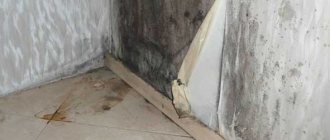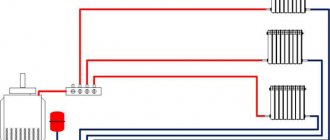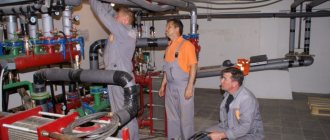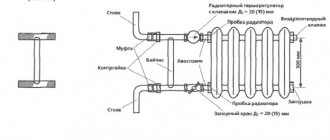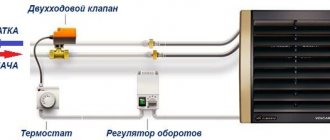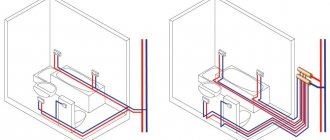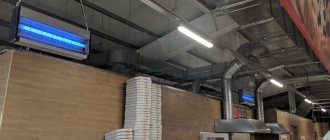The most common way to provide thermal energy to apartment buildings is central heating. Heating medium supply carried out by means of heating mains from central boiler houses or CHP. The heated liquid is taken over by the heat point... It produces primary heat metering, provides regulation of the supply, distributes it to consumers. There are other options for heating apartments. Among the most common: individual heating of an apartment building, heating of a single apartment.
Each scheme has advantages and disadvantages, the choice of the most convenient one depends on a number of factors: the proximity of the highways, their condition, the expediency of using the energy of remote boilers. In any case, the design of new communications, the reconstruction of old networks should include the development of mechanisms for regulating the supply of heat to apartment buildings. This is not so much a matter of comfort as of saving energy resources.
Automation of the process of regulating heat supply MKD
The existing system of transportation and distribution of heat energy is far from ideal. Its imperfection is especially acute during the off-season. It often happens that the weather is stable outside the window, the batteries stubbornly heat the already warm rooms. This situation is due to the fact that the only link in the chain of enterprises, communications and coolant supply devicesthat has the ability to influence the heat supply process is a boiler house or a CHP. But even they do not have the possibility of flexible regulation, they do not have mechanisms that allow them to instantly react to a change in the weather.
Ideal option regulation of heat supply in an apartment building there will be such a project, in the implementation of which it becomes possible to regulate the temperature of each room separately. This solution makes it possible to provide individual metering of heat supply, which in turn makes it possible for residents not to pay for heat that simply flies out through the open vents.
Individual metering of heat supply allows the consumer to carry out regulation of the amount of consumed heat energy... This can be achieved by setting a lower temperature for rooms that are not in use and raising it as needed.
Heat regulation can be realized by shutting off the taps on the radiators. In addition, you can entrust the regulation process to automation. Modern industry offers various devices that allow you to regulate the room temperature. The most common of these are radiator thermostats. These are devices consisting of a thermostatic head and a valve. The sensor measures the room temperature, controls the valve. Depending on the presettings, the valve increases or decreases the heating medium flow by adjusting the heating level.
Due to the possibility of precise adjustment, this device allows you to regulate the microclimate inside the building, maintain a comfortable atmosphere, and save energy. There are different types of radiator thermostats. Most of them allow you to set the temperature value that the owner of the room wants to receive. There are more complex models. Some of them allow you to set the temperature for different times of the day, for example, they can limit the supply of heat during the day, when there is no one in the apartment, and in the late afternoon they can warm the room to a comfortable level.
Heat supply flushing methods
It is not recommended to start flushing the heating system without preliminary preparation. It is necessary to determine the chemical composition of the scale, select a specific type of equipment for cleaning.
The technological map, which prescribes all stages of the procedure, will help you to perform the necessary steps correctly. The last regulation ends with the treatment of the inner area of the pipes with a chemical composition to prevent the appearance of corrosion, lime deposits, scale.
The main flushing techniques are as follows:
- chemical method;
- hydrodynamic;
- hydropneumatic.
Chemical flushing of the coolant
This method does not provide for the intervention of mechanical devices and the dismantling of radiators. Cleaning is carried out with chemicals or solutions.
However, the use of the method can damage the inner plane of aluminum radiators, which is fraught with their destruction.
If the heating network is not heavily clogged, you can use reagents:
- sodium hydroxide;
- vinegar essence;
- ordinary phosphoric acid or condensed acid;
- milk whey.
However, it is better to use compounds that allow you to thoroughly clean the pipes. The instructions for the drugs stipulate the material, the nature of the layers.
Chemical treatment can be carried out using additional equipment - a booster, consisting of a centrifugal pump and a large capacity. The first one is connected at the rupture of the supply centralized system with a heating boiler. A valve must be installed at the outlet of the circuit to discharge the spent chemical.
For high-quality corrosion of lime deposits, experts recommend leaving the reagent in the network for several days, depending on its slagging. However, in order to avoid exposure to the chemical on the pipes, the circuit must be rinsed after cleaning with industrial or tap water.
More gentle metal structure - dispersed cleaning mode. The method differs from the chemical method in that the reagent destroys the mechanical bonds of the deposits themselves, without interacting with the material of the heating communications.
Hydrodynamic cleaning
The described operation is carried out using specialized equipment. One of them is a powerful centrifugal pump with a hose having a small diameter end piece. A strong pressure of water cleans scale and deposits from the walls of the heating mains, removes them through the return.
The disadvantage of this method is the impossibility of passing the hose on the bends of the system without opening the heating block in many places.
Mechanical washing method
Method for cleaning radiators, small footage of pipes. The shut-off valves, expansion tank and centrifugal pump must be cleaned separately. Before the procedure, it is necessary to carry out a minimum drain of the system at home, and then close the inlet and drain valves. Only after that they start to reset the rest of the carrier.
The discharge takes place through a drain valve installed in the basement, which is connected to the sewer through a hose. This will prevent flooding of the technical floor with water. The heatsinks are cleaned by unscrewing the plug and discarding the media. Removing the battery and handling, however, will improve the thermal performance of the heatsink.
After dismantling the radiators, heating wiring sections to the courtyard, the equipment is cleaned with a cable with a tip in the form of a brush. The insertion of the tool into the batteries is carried out in the position of the reverse supply of the heat resource to improve the removal of scales and layers. Cleaning is carried out until the rinse water becomes clear.
Hydropneumatic
It belongs to an efficient and equipment-friendly way of cleaning heating circuits. Contained in a high pressure air jet.The compressor creates turbulent flows of high power inside the communications, leading to the breakdown of build-ups and washing out the accumulated dirt.
The operation is carried out with a pneumatic gun, which delivers short-term impulses. Lime deposits are discharged through the open plugs of the radiators. The initial purging procedure is performed against the flow of the coolant, the second one is performed clockwise. Improve aerial operation to dismantle batteries with outdoor cleaning.
Electrohydropulse cleaning option
The method is based on the formation of an electric discharge, the shock wave of which breaks up lime deposits on the inner walls of the system, without causing harm to the latter. For cleaning, you need a voltage generator, a coaxial cable for supplying high-frequency signals.
The efficiency of the method is high, therefore, the dismantling of radiators and the entire heating circuit is not provided. After the destruction of the scale, the coolant is washed, the water goes into the sewer.
Heat regulation in individual heating systems
The concept of individual heat supply means that the boiler room is located directly in an apartment building. For its placement, basements, basements are used, modular boiler rooms are also used, which are placed on the roofs of buildings.
The implementation of individual heating in apartment buildings is a rather expensive project. It requires a significant investment, however, it provides an opportunity to save money. Length of mains for individual heat supply limited by the size of the building, which entails small heat losses during transportation. In addition, easy access to the boiler room equipment makes it possible to more efficiently regulate the heat supply to the apartment building.
A separate case of individual heat supply is the installation of autonomous heating in the apartments of an apartment building. For this, boilers are used, most often gas ones, which are part of a closed heating system. Such a solution makes it easy to automate the process by using devices that can regulate the temperature of a single room.
Legislative regulation on the cleaning of heat supply
Flushing and pressure testing of heating systems is regulated by regulatory enactments and is included in the register of mandatory operations for the operation of heating structures. The regulation is enshrined in current legal acts on the filing of appeals, complaints in case of failure of the managing organizations to fulfill their duties.
Russian Government Resolution No. 354
Ordinance number 354 refers to the annual cleaning of the household heating circuits in the form of flushing. The procedure is also carried out after the installation of communications, overhaul and current, expressed by the replacement of pipelines.
In the case of an open system, disinfection is done. The purpose of the treatment is to remove dirt, silt, scale and limescale from the inner walls of the pipes.
The operation is carried out by the following available methods:
- hydraulic;
- hydropneumatic;
- chemical.
Membranes, nozzles of hydraulic elevators are removed for this period. Recuperators and regenerators are cleaned mechanically or chemically. Uncleaned and disinfected media lines must not be brought into service. After the operation, the structure is filled with water.
Gosstroy Decree No. 170
Decree of the Federal Building Authority of Russia No. 170 (in the current version of 2020) covers the issues of the correct operation of the heating structure. The regulation indicates a summer revision of valves, flushing of building blocks, elimination of permanent and temporary blockages.
If the apartment batteries do not warm up, their hydropneumatic procedure is carried out.Section V recalls the annual treatment of the thermal configuration after the end of the heating period, and in case of replacement of elements of open circuits, they are disinfected.
Communications are run with a volume of cold water that exceeds the required consumption of hot resource at least 3-5 times, until it is completely clarified.
However, employees of managing structures often carry out processing, justifying their behavior by the fact that the decree of the Federal Agency is intradepartmental and is not subject to implementation. Although Art. number 2.6 speaks about the preparation of the housing stock for the winter by its owner, local government institutions.
Watch the video: "Flushing heating systems using a hydro-pneumatic ram."
Ordinance No. 290 on flushing and cleaning heating
The order of the Russian state power number 290 provides a list of services, works that must be performed to maintain the health of residential multi-storey buildings.
The second chapter indicates that work is carried out to save heat consumption:
- hydraulic tests of the stability of communications;
- flushing of heating batteries, adjustment of heat supply units with preliminary commissioning of furnaces;
- release of air plugs from the structure;
- flushing of networks to wash away scale-corrosive deposits;
- processing of heat exchange devices.
The Resolution does not give a clear indication of the frequency of their implementation, however, it makes a footnote to the order of the State Construction Committee. Timing procedures must adhere to country law, but flushing can be done at the discretion of the apartment owners' meeting.
GOST P 56501-2015

7 facts about heating radiators.
State standard number P56501-2015 (as amended in 2020) also stipulates the conditions for processing networks. His article # 5 talks about organizing seasonal training. Shortly before the end of the coolant supply, the contractor draws up and coordinates his actions with the heating or other resource-supplying structure, a plan for carrying out remedial measures - flushing, pressure testing, conservation of communications.
The contractor fulfills the conditions according to the agreed schedule, after which the acts are drawn up. The first is a legal entity that provides economic services to a multi-storey building. Before the end of winter, the housing office must draw up a list of preventive and repair work, including cleaning the heat consumption units. It is carried out after stopping the supply of the coolant or blocks or elements that have passed diagnostics.
Flushing of the heating systems of an apartment building is performed in the ways specified by the operating regulations. The pressure of the liquid in the structures is not more than the working pressure, the air pressure is not more than 0.60 MPa. The water supply rate rises above the calculated one by half a meter per second or more. After complete clarification of the flushing liquid at the outlet of the block, the cleaning is completed. GOST P 56501-2015 prohibits leaving the circuit empty.
Building codes SNiP 3.05.03-85 (in the new edition of 2020) also prescribe the systematic processing of heat consumption loops.
Referring to the aforementioned state acts, apartment owners have the right to demand periodic flushing of communications from housing firms.
Single-pipe version of MKD heat supply
The simplest option for heating an apartment building is a one-pipe system. The heat carrier is fed from the bottom up, it fills the radiators, gives off heat and moves to the next consumer. This system has a number of significant disadvantages. One of the main ones is significant heat loss during transportation. The last consumers in the chain receive a slightly heated liquid.
In addition, the one-pipe system makes it almost impossible to regulate the heat supply in an apartment building.It is impossible to install taps or automatic control devices on the supply pipelines, since a decrease in the flow rate inside any of them will affect the entire system. You also need to remember about possible emergency situations. A one-pipe system does not allow one of its components to be replaced without completely draining the water from the system. A minor breakdown may result in stopping the supply of heat to all consumers.
Heating of residential buildings
Heating of residential buildings - this is the supply of thermal energy through centralized heat supply networks and in-house engineering heating systems, which ensures the maintenance of the standard air temperature in residential and non-residential premises of an apartment or private residential building, as well as in premises that are part of the common property of an apartment building.
If heat energy for the needs of heating premises is supplied to the in-house engineering systems through centralized networks of engineering and technical support, then the heat supply organization begins and ends the heating season within the time limits established by the authorized body. The heating season must start or end on the day following the end of the 5-day period, during which the average daily outdoor temperature is respectively below 8 ° C or above 8 ° C.
If, in the absence of centralized heat supply, the production and provision of utility heating services by the contractor are carried out using equipment that is part of the common property of the owners of premises in an apartment building, then the conditions for determining the start and end dates of the heating period are established by the decision of the owners of premises in an apartment building or owners of residential buildings. If they do not accept such a decision, the heating period begins and ends within the time limits established by the authorized body when heat energy is supplied for the needs of heating the premises to the in-house engineering systems through the centralized networks of engineering and technical support.
Relations in the field of heating residential buildings are regulated by the Federal Law of July 27, 2010 N 190-FZ "On Heat Supply".
General rules for the implementation of heat supply to residential buildings are established by Article 7 of Chapter 3 of Federal Law No. 416-FZ of December 7, 2011, and the provision of utilities for heating apartment buildings and residential buildings is carried out in accordance with the Rules for the provision of utilities to owners and users of premises in apartment buildings and residential buildings approved by the Decree of the Government of the Russian Federation of May 6, 2011 N 354 (hereinafter referred to as the Rules).
The conditions for the provision of utility services for heating to owners and users of premises in an apartment building are determined depending on the chosen method of managing an apartment building.
The volume of heating consumed for the billing period in a residential or non-residential premises of a communal resource is determined according to the indications of an individual meter.
In the absence of an individual metering device for the consumption of thermal energy, the volume of the communal resource is determined based on the standards for the consumption of the communal heating service.
The estimated volume of heat energy consumption for special cases is determined based on the data specified in clause 59 of the Rules, and in the absence of such data, it is determined by a calculation method similar to that defined in the energy supply agreement between the contractor and the heat supply organization in order to calculate the volume of consumption of a utility resource, not equipped with individual metering devices, and in the absence of such a condition - by the calculation method established in accordance with the requirements of the legislation of the Russian Federation on heat supply.
The amount of electricity for each apartment or non-residential premises provided for the billing period for general house needs in an apartment building equipped with a collective metering device for heat energy, if in such an apartment building part or all residential and non-residential premises are equipped with individual metering devices for heat energy, is determined according to formula 13, and in their absence - according to formula 14 of Appendix 2 to the Rules.
Requirements for the quality of utilities for heating are defined in Appendix 1 to the Rules:
- Uninterrupted round-the-clock heating during the heating period <6> Permissible duration of interruptions in the provision of public services and permissible deviations in the quality of public services: permissible duration of a heating interruption: no more than 24 hours (in total) within 1 month; no more than 16 hours at a time - at an air temperature in residential premises from +12 ° C to the standard temperature specified in paragraph 15 of this annex; no more than 8 hours at a time - at an air temperature in residential premises from +10 ° C to +12 ° C; no more than 4 hours at a time - at an air temperature in residential premises from +8 ° C to +10 ° C
- Conditions and procedure for changing the amount of payment for a utility service when providing utility services of inadequate quality and (or) with interruptions exceeding the established duration: for each hour of exceeding the permissible duration of a heating break, calculated in total for the billing period in which the specified excess occurred, the amount of payment for utility service for such a billing period is reduced by 0.15 percent of the amount of payment determined for such a billing period in accordance with Appendix No. 2 to the Rules, taking into account the provisions of Section IX of the Rules
- Permissible duration of interruptions in the provision of public services and permissible deviations in the quality of public services: permissible excess of the standard temperature - no more than 4 ° C; permissible decrease in the standard temperature at night (from 0.00 to 5.00 hours) - no more than 3 ° C; lowering the air temperature in the living quarters during the daytime (from 5.00 to 0.00 hours)
- Permissible duration of interruptions in the provision of utility services and permissible deviations in the quality of utility services: deviation of pressure in the internal heating system from the established values is not allowed
———————————
These requirements are applied at an outside air temperature not lower than the calculated one adopted when designing the heating system, subject to the implementation of measures for warming the premises (GOST R 51617-2000).
<6> In the case of application of paragraph 14 of this annex, paragraph 15 of this annex shall not apply from the moment the heating interruption begins.
<7> The air temperature in living quarters is measured in a room (if there are several rooms, in the largest living room in terms of area), in the center of the planes spaced 0.5 m from the inner surface of the outer wall and the heating element and in the center of the room (point the intersection of the diagonal lines of the room) at a height of 1 m. In this case, the measuring instruments must comply with the requirements of standards (GOST 30494-96).
Heat supply and regulation in a two-pipe system
This option is more complicated, but it allows you to significantly expand the capabilities of the mechanisms regulation of heat supply to each consumer... The difference between the system is that the coolant that has given up part of the energy does not continue to move along the same pipe to the next consumer, it flows into the second pipe, the "return". Due to this, the coolant has approximately the same temperature all the way, for each radiator.
It is this solution that makes it possible to implement regulation of heat supply in an apartment buildingusing each individual radiator. The temperature can be controlled either manually, with a valve, or automatically, using thermostats.
Regardless of how the heat supply is implemented, the system must include devices for automatic metering and regulation of heat supply in an apartment building. This allows not only to provide housing with the heat necessary for life, but also to significantly save energy resources.
Heat calculation
Knowing the principles of calculation, you can determine the cost of heating in the house. The rules are established by the administration of the settlement based on standards. It is they who are used to establish the amount of payment.
Regulatory rules usually last for about 3 years. If there is an increase, then it will definitely justify. The utilities ask the administration to raise the cost of heating. If the offer matches reality, then the tariffs are increased.
Heat supply rules are set in gigacalories. The calculation takes into account:
- Climate;
- Average temperature parameters;
- Room type;
- Materials;
- The quality of engineering structures.
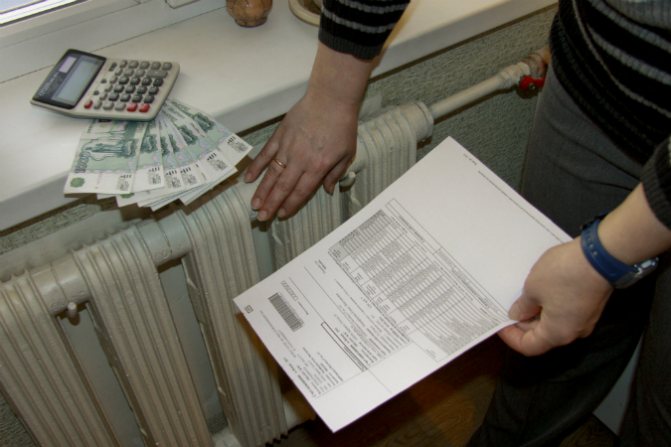

If before the payment was taken from tenants only for the resources spent, now there are general housekeeping ones. TNow we have to pay for the heating of entrances and basements. Payments are obligatory for everyone.
Each tenant has the right to reduce costs. To do this, you need to insulate the apartment and install your own meter. In this case, the fee will be charged only for personally spent resources.
The equipment can be installed by those organizations that have a license for this type of work. The device is subject to sealing by control companies.
